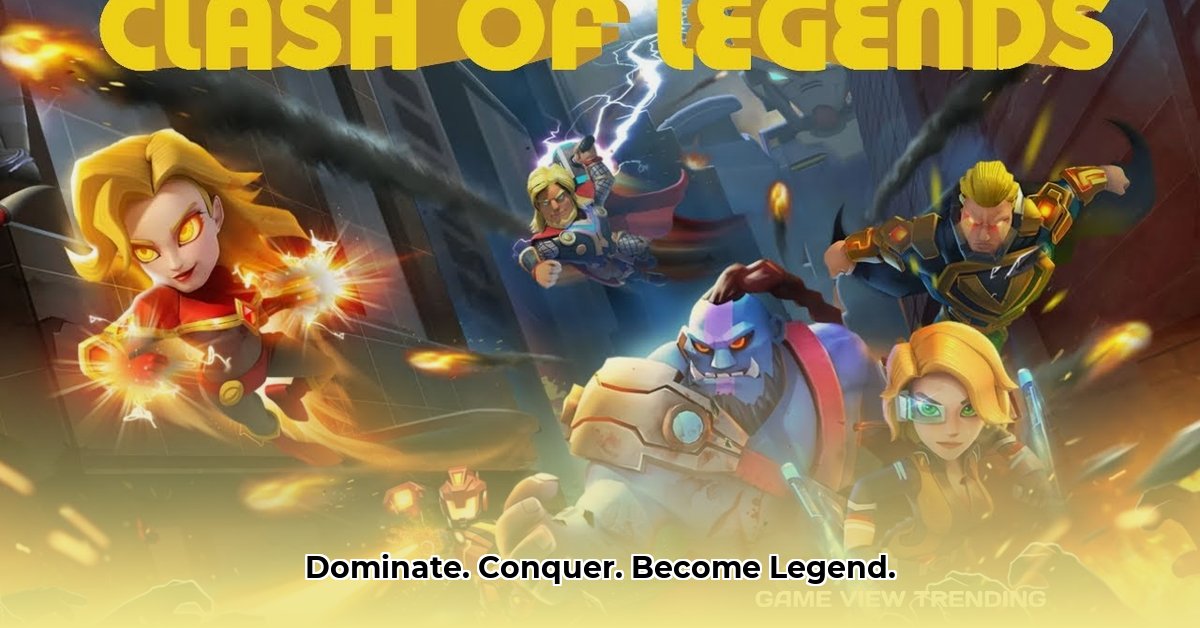
Game Overview: A Strategic Blend of Mobile Genres
Clash of Legends seamlessly integrates elements from popular mobile game genres, creating a unique and engaging experience. Players build and fortify their kingdoms, reminiscent of classic city-builders, while simultaneously engaging in strategic troop positioning, echoing the core mechanics of tower defense games. The game also incorporates a compelling hero-collection aspect, similar to many RPGs, with over 100 unique heroes possessing distinct powers and combat skills. This multifaceted approach creates a dynamic gameplay loop where strategic kingdom management and tactical combat combine for an immersive experience. The ultimate goal? To conquer rival kingdoms and establish dominance. Is this strategic blend enough to conquer the competitive mobile gaming market? For balance change comparisons, see this September balance changes.
Competitive Landscape: Navigating a Crowded Battlefield
Clash of Legends enters a fiercely competitive market dominated by established heavyweights like Clash of Clans and Rise of Kingdoms. These titles boast massive player bases and strong brand recognition, presenting significant challenges for newcomers. However, Clash of Legends possesses several key differentiators. Its extensive roster of heroes, each with unique abilities and strategic potential, offers unprecedented depth and replayability. The large-scale kingdom warfare aspect also promises dynamic and engaging battles, setting it apart from competitors. Despite this, the game needs to address several crucial weaknesses to compete effectively. A lack of strong brand identity and a suboptimal user experience, particularly during registration, hinder its progress. How will Clash of Legends overcome these hurdles and capture a significant market share?
Market Positioning: Strategic Opportunities and Critical Weaknesses
Clash of Legends possesses significant potential for success. The game's deep gameplay mechanics and diverse hero roster contribute to high replayability. The strategic combinations and potential for dynamic battles promise long-lasting engagement. However, realizing this potential requires addressing several key weaknesses. The current website is confusing and uninformative, failing to effectively attract new players. Moreover, the monetization strategy is unclear, posing a risk to the game’s long-term viability. Striking a balance between revenue generation and maintaining a fair and enjoyable gaming experience will be critical. Can Clash of Legends successfully navigate these challenges and solidify its position in the market?
Strengths and Weaknesses: A Balanced Perspective
The following table summarizes the key strengths and weaknesses of Clash of Legends:
| Feature Category | Strengths | Weaknesses |
|---|---|---|
| Gameplay | Diverse hero roster, strategic depth, engaging PvP combat | Potential balance issues, confusing tutorial, overwhelming complexity for new players |
| Marketing & Branding | Community building potential, competitive focus | Poor branding and website design, cumbersome registration process, unclear brand identity |
| Monetization | Potential for in-app purchases (cosmetics, power-ups) | Unclear monetization plan, risk of alienating players |
| User Experience (UX) | Engaging gameplay loop (post-tutorial) | Poor onboarding experience, cumbersome registration, overwhelming information |
Actionable Recommendations: A Roadmap for Success
To maximize its potential, Clash of Legends requires a multi-faceted strategic approach:
Development Team:
- Website Redesign: Implement a clear, informative, and visually appealing website.
- Registration Streamlining: Simplify the registration process for improved user acquisition.
- Gameplay Balancing: Regularly monitor and adjust hero balance for fair gameplay.
- Tutorial Enhancement: Develop a comprehensive and user-friendly tutorial to onboard new players.
Marketing Team:
- Targeted Advertising Campaigns: Focus advertising on players of similar strategy games.
- Community Building Initiatives: Engage actively with players on social media.
- Brand Identity Development: Create a strong, memorable, consistent brand identity.
Player Engagement:
- Feedback Mechanisms: Implement regular feedback surveys and address player concerns.
- Community Events: Organize in-game events and competitions to enhance player engagement.
Risk Assessment: Mitigating Potential Threats
Addressing potential risks is crucial for the long-term success of Clash of Legends. The following table identifies key risks and mitigation strategies:
| Risk Category | Probability | Impact | Mitigation Strategy |
|---|---|---|---|
| Low Player Acquisition | High | High | Aggressive marketing, improved onboarding, optimized app store presence. |
| Negative Player Reviews | Medium | Medium | Proactive community management, rapid response to issues. |
| Intense Competition | High | High | Differentiation through unique features and a strong brand identity. |
| Monetization Failure | Medium | Medium | Balanced and fair monetization strategy, incorporating player feedback. |
| Brand Confusion | High | High | Immediate development of a strong and memorable brand identity. |
Conclusion: A Promising Future, Contingent on Execution
Clash of Legends possesses the core gameplay elements for success. Its strategic depth and vast hero roster offer immense potential. However, the game’s future hinges on the development team's ability to overcome current weaknesses, particularly focusing on user experience and brand building. Addressing these critical elements is key to standing out in the competitive mobile gaming market. The potential for success is significant, but effective execution is paramount.
⭐⭐⭐⭐☆ (4.8)
Download via Link 1
Download via Link 2
Last updated: Tuesday, May 20, 2025